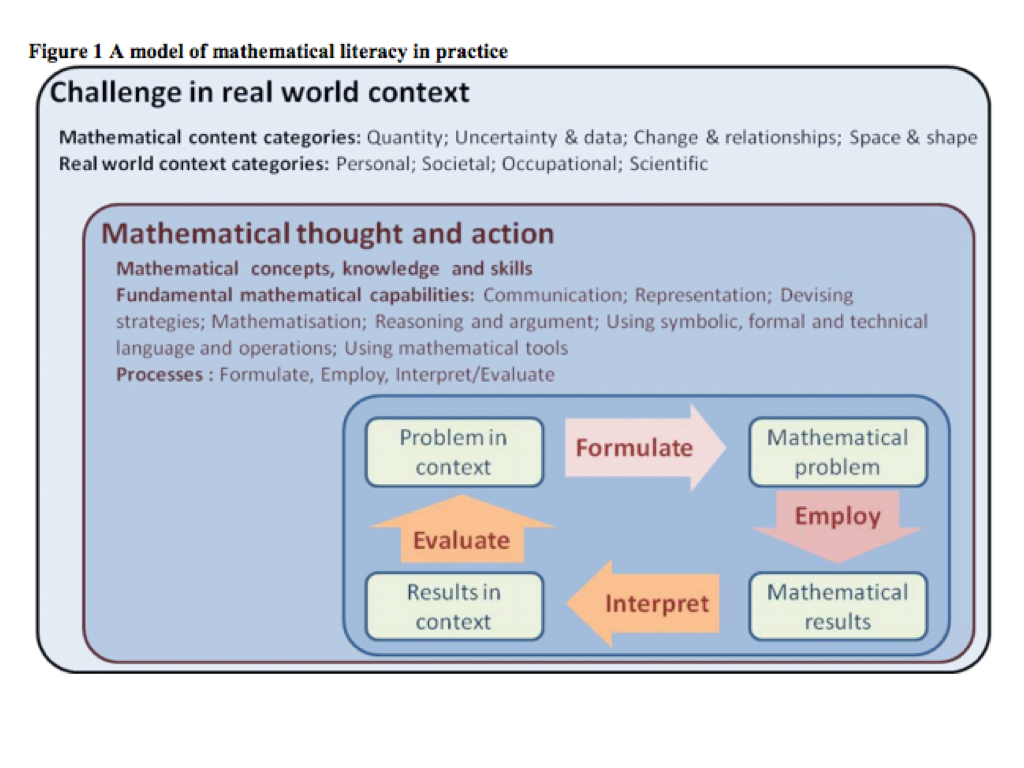Math Literacy, according to the PISA’s Math Framework (2015), places the emphasis on the math modeling process and describe it as the “ability of students to analyze, reason and communicate ideas effectively as they pose, formulate, solve and interpret mathematical problems in a variety of situations. The PISA mathematics assessment focuses on real-world problems, moving beyond the kinds of situations and problems typically encountered in school classrooms. In real-world settings, citizens routinely face situations in which the use of quantitative or spatial reasoning or other cognitive mathematical competencies would help clarify, formulate or solve a problem. Such situations include shopping, traveling, cooking, dealing with personal finances, judging political issues, etc. Such uses of mathematics are based on the skills learned and practiced through the kinds of problems that typically appear in school textbooks and classrooms. However, they also demand the ability to apply those skills in a less structured context, where the directions are not so clear, and where the student must make decisions about what knowledge may be relevant and how it might be usefully applied.” PISA 2015 Math literacy document
They continue to state that “Citizens in every country are increasingly confronted with a myriad of tasks involving quantitative, spatial, probabilistic and other mathematical concepts. For example, media outlets (newspapers, magazines, television and the Internet) are filled with information in the form of tables, charts and graphs about subjects such as weather, climate change, economics, population growth, medicine and sports, to name a few. Citizens are also confronted with the need to read forms, interpret bus and train timetables, successfully carry out transactions involving money, determine the best buy at the market, and so on. The PISA mathematics assessment focuses on the capacity of 15-year-old students (the age when many students are completing their formal compulsory mathematics learning) to use their mathematical knowledge and understanding to help make sense of these issues and carry out the resulting tasks. PISA defines mathematical literacy as: …an individual’s capacity to identify and understand the role that mathematics plays in the world, to make well-founded judgments and to use and engage with mathematics in ways that meet the needs of that individual’s life as a constructive, concerned and reflective citizen. Some explanatory remarks may help to further clarify this domain definition: • The term mathematical literacy emphasises mathematical knowledge put to functional use in a multitude of different situations in varied, reflective and insight-based ways. Of course, for such use to be possible and viable, many fundamental mathematical knowledge and skills are needed. Literacy in the linguistic sense presupposes, but cannot be reduced to, a rich vocabulary and substantial knowledge of grammatical rules, phonetics, orthography, etc. To communicate, humans combine these elements in creative ways in response to each real-world situation encountered. In the same way, mathematical literacy presupposes, but cannot be reduced to, knowledge of mathematical terminology, facts and procedures, as well as skills in performing certain operations and carrying out certain methods. It involves the creative combination of these elements in response to the demands imposed by external situations.”
